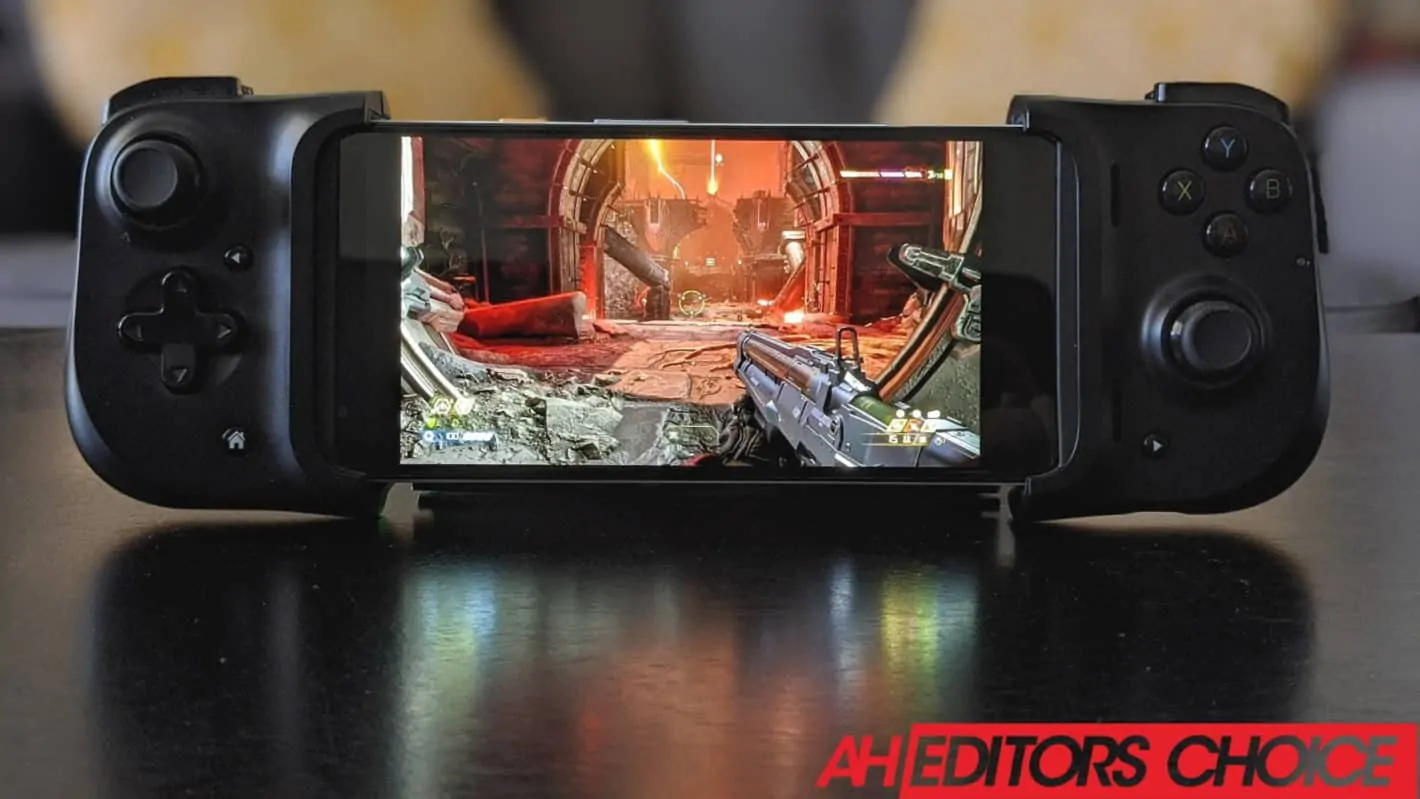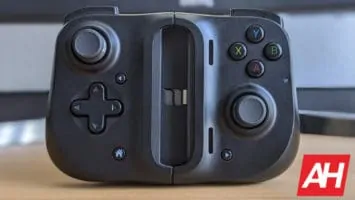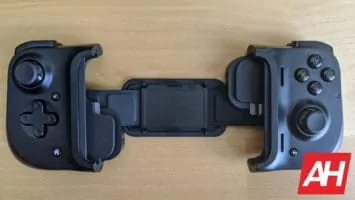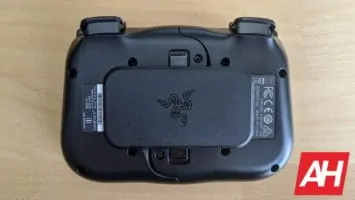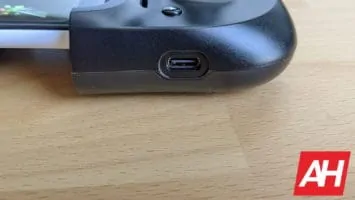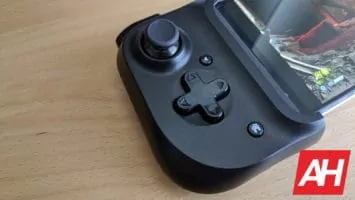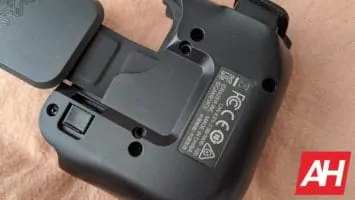Mobile has fast become one of the most popular platforms for gaming, and the Razer Kishi is a tool to enhance that experience.
Over the past month, I’ve had the pleasure of being able to use the Kishi prior to its official launch here in the US. And without mincing words, it’s the best mobile game controller I’ve ever used. There are numerous reasons for that. However the main reason is the device’s ultra-low latency gameplay.
Thanks to Razer’s design to make this essentially a wired controller (the USB Type-C plug goes goes directly into your phone’s port instead of connecting through Bluetooth), the Razer Kishi provides what feels like a latency-free experience. It’s this wired design that makes that possible. Because the controller doesn’t have to relay your inputs over a Wi-Fi or Bluetooth connection.
Beyond that particular detail, the controller is simply well-made. And is yet again an example of Razer’s ability to come up with, and engineer a striking yet functional product.
The Razer Kishi is designed for console-level control
When it comes to design, aesthetics are definitely a huge part of the equation. And with Razer, you can be certain that the aesthetic is definitely on the minds of the design team. Every time.
But it’s not just about the aesthetic. Not with the Kishi controller. There’s a clear and concise point to its design beyond how it looks – it offers up a functional, ergonomic feel to make mobile gaming even more comfortable and give gamers “console-level control.”
At least that’s Razer’s selling point. That and the ultra-low latency gameplay. Now, I don’t know that I would ever describe this controller to a friend as “ergonomic,” but it does feel good while holding it. I do feel like I have better control in my games than with other controllers.
Little details make a big difference here. Take the back of the controller for example. There’s this flat plate with the triple snake logo on it that helps lock the controller in its compact state when not in use.
Under that plate, there are these little carved out sections that feel perfect for resting some of your fingers. Depending on how you hold the controller, at least one or two fingers will end up sitting there. It just feels good and more comfortable than if they weren’t there at all.
A lightweight build + responsive buttons = long, comfortable gaming sessions
Sometimes you only have a few minutes to game and other times you have all day. Whether you’re just popping into your favorite game to grab the daily bonuses or you’re settling in for the long haul, the Kishi is built for it.
It’s pretty lightweight which makes it easy to hold for longer periods of time. So if do plan to game for hours, you shouldn’t get tired of holding the controller.
Personally I felt this was a big strength, as other controllers have felt heavy after a little while. A perfect example of this is the Stadia controller. Primarily I play Stadia through the Pixel 3a XL. And the easiest way to do that with the Stadia controller is by using the CLAW attachment for it.
This makes the whole thing very top-heavy though. With the Razer Kishi this isn’t an issue. Not only is not top-heavy because the phone is clamped in the middle, but the controller itself is not very heavy. Playing games for hours was never an issue and was a lot more comfortable as I never really experienced any fatigue.
Add to that what feels like exceptional buttons and everything went off without a hitch. All the buttons had a satisfying response to them when being pressed. And that’s an area where some controllers struggle.
Compared to something like the Razer Junglecat, the Kishi is slightly a cut above. And compared to other mobile game controllers, the Kishi is a clear winner.
Pass-through charging isn’t always needed, but it’s invaluable
One of the bigger problems one might face when gaming on a smartphone is the battery life of the phone. This worry is only increased when using the phone for cloud gaming options like Stadia.
Thankfully the Razer Kishi has pass-through charging. Something that wasn’t always needed, but it was still an invaluable feature to have.
Even though the Kishi isn’t Bluetooth and therefore doesn’t drain the battery a whole lot more than when the phone just sits there, playing games through Stadia tends to drain the battery quite a bit. During my longer gaming sessions, I would just plug in the phone thanks to the USB-C pass-through charging.
Having this feature at all has been great. But it’s even better because Razer positioned the port in a place where the cable won’t get in the way. When you’re holding the controller, the port is on the bottom. Sitting near your right hand.
This is something that anyone is likely end up using at one time or another. And it will absolutely save you a time or two if your phone is about to die in the middle of a gaming session.
It works with cloud gaming services, which is a huge plus
This is a mobile controller. So it was definitely designed with mobile gaming in mind. It also works with cloud gaming services such as Stadia, and this always seems to have been the main drive behind it.
Using it with cloud gaming is how I have been using it almost exclusively. For me, this has been a massive boon. The Stadia controller is nice. But it’s lack of wireless connectivity to the phone and the top-heavy CLAW attachment make using it a little bit cumbersome. And while still cool, it never felt optimal to me.
The Razer Kishi changes the game. It’s design and the pass-through charging make this a dream controller for use with Stadia, GeForce NOW, and xCloud. And it’s the only way I’ll play games on Stadia now. When I’m on the phone, at least.
If I ever decide to boot up the Chromecast Ultra and Play Stadia games that way, then the Stadia controller comes back into the fold. Otherwise, it now serves as more of a showpiece. This is how good the Kishi is.
Because of how comfortable it feels while playing games, it’s made the Stadia controller almost obsolete for me. That’s not a dig at Google. Because I still really like the Stadia controller too. Rather, this is a testament to how good Razer is at making gaming peripherals.
Razer is not perfect, don’t get me wrong. And even this controller has one or two downsides. But it definitely is a beacon of Razer’s uncompromising attitude to deliver a fantastic gaming product. For gamers by gamers. That’s the motto. And that really comes through here.
Don’t leave the Razer Kishi plugged into your phone when not in use
One of the best parts about the Razer Kishi is that it doesn’t use Bluetooth technology. So, it doesn’t drain the battery like it would if it were Bluetooth.
To be more clear though. It just doesn’t drain the battery as much. It does however still drain the battery. So you should avoid leaving it plugged in while you’re not using it. There have been a few times where I left the Pixel 3a XL plugged into the controller thinking everything would be fine.
And for the most part it was. Except after coming back to it later in the day for another game session, I found the phone to be lower on battery power than I had expected. Especially for the phone sitting with the screen off doing nothing all day.
This isn’t a major issue, but it is a small pain point. And something to keep an eye on. Because the last thing you want is to come back when you’re ready play, pick up the Kishi with the phone slotted into it, and realize your battery is at 12-percent.
Luckily you can just use the pass-through charging if you’re able. But you may not always have your charger on you. Or maybe you only have one charger and something else is already plugged into it.
Again, this is just something to be aware of because it’s in no way a deal breaker. It’s simply going to be a good habit to unplug the phone from the Kishi when you’re done. Or at the very least plug the controller into a charger to use the pass-through charging feature.
Ultra-low latency gameplay for a more seamless experience
To many users, the difference between the ultra-low latency offered with the Razer Kishi and the lack of it in something like a DualShock 4 or Xbox One controller might be unnoticeable.
If you tend to pay attention to these things though, you should feel a slightly better experience with the Kishi. We’re not talking a vast improvement over other controllers. But there is an improvement. And that is sure to make a difference to some users.
Razer says it provides “instant button response.” It certainly feels like that’s the case. But what it comes down to for me is that it feels just as responsive and quick when pressing buttons as it does on something like the DualShock 4. Really, it feels slightly better.
Then there’s the added benefit of holding my phone in between the two sides of the controller for a big convenience of not having to prop it up against something.
Overall, Razer really knocked this out of the park. The buttons feel great, the design is solid and comfortable, and the native support for cloud gaming in addition to USB-C pass-through charging is a huge benefit.
The Kishi is not the cheapest mobile controller around. But, for $80 (which is still a tad high for some), everything the Kishi offers makes the price worth it.

